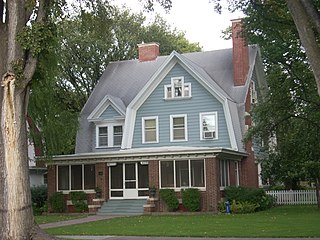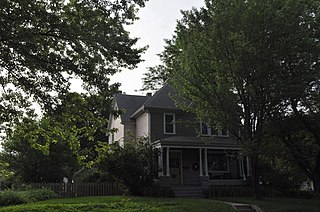
The University of South Dakota (USD) is a public research university in Vermillion, South Dakota. Established by the Dakota Territory legislature in 1862, 27 years before the establishment of the state of South Dakota, USD markets itself as the flagship university for the state of South Dakota and the state's oldest public university. It occupies a 274 acres (1.11 km2) campus located in southeastern South Dakota, approximately 63 miles (101 km) southwest of Sioux Falls, 39 miles (63 km) northwest of Sioux City, Iowa, and north of the Missouri River.

Westland Mansion was the home of Grover Cleveland, the 22nd and 24th President of the United States, from his retirement in 1897 until his death in 1908. The house is located in the historic district of Princeton, New Jersey, and is a National Historic Landmark also known as the Grover Cleveland Home.

The Benjamin Harrison Presidential Site, previously known as the Benjamin Harrison Home, is the former home of the twenty-third president of the United States, Benjamin Harrison. It is in the Old Northside Historic District of Indianapolis, Indiana. Harrison had the sixteen-room house with its red brick exterior built in the 1870s. It was from the front porch of the house that Harrison instituted his famous Front Porch Campaign in the 1888 United States presidential campaign, often speaking to crowds on the street. In 1896, Harrison renovated the house and added electricity. He died there in a second story bedroom in 1901. Today it is owned by the Arthur Jordan Foundation and operated as a museum to the former president by the Benjamin Harrison Foundation.
William Ogden "Doc" Farber was an American political scientist, professor emeritus at the University of South Dakota, and founder of the South Dakota Legislative Research Council. Notable protégés that credit his teachings as influences include Tom Brokaw, Al Neuharth, Dennis Daugaard, Dusty Johnson, and Pat O'Brien.

The University of South Dakota School of Law also known as University of South Dakota Knudson School of Law or USD Law in Vermillion, South Dakota, United States, is a professional school of the University of South Dakota and the only law school in the state of South Dakota. Established in 1901, by U.S. Ambassador Bartlett Tripp and U.S. Senator Thomas Sterling. The law school is home to approximately 168 students and has more than 3,000 alumni. With 168 J.D. candidates, it is currently the second-smallest law school and smallest public law school student population among the American Bar Association accredited law schools.

The Birches is a house at the southeast corner of the junction of NY 9D and 403 in the hamlet of Garrison, New York, United States. It was built for William H. Osborn, as part of his nearby Wing & Wing estate, by architect Ralph Adams Cram in the Gothic Revival architectural style. Osborn was a 19th-century railroad tycoon, who became one of the most prominent railroad leaders in the United States. In addition to Wing and Wing and the Birches, Osborn famously constructed Castle Rock, his great summer estate overlooking the Hudson River.

The Joseph Bell DeRemer House is a Dutch Colonial Revival style house located on Belmont Road in the Near Southside Historic District of Grand Forks, North Dakota, United States. The house was built in 1906 for the architect Joseph Bell DeRemer, who designed the home himself. As an example of a middle-class house the structure is remarkable for details and quality associated with the public and commercial buildings designed by the DeRemer firm.

The Architecture of Buffalo, New York, particularly the buildings constructed between the American Civil War and the Great Depression, is said to have created a new, distinctly American form of architecture and to have influenced design throughout the world.

The F. H. Miller House is a historic building located in the central part of Davenport, Iowa, United States. The house served as the official residence for two of Davenport's Catholic bishops and as a bed and breakfast. The building now houses the Office of Advancement and Alumni Relations for St. Ambrose University, and is called Alumni House. It has been listed on the National Register of Historic Places since 1983.
Wallace L. Dow, often known as W.L. Dow, was an architect of Sioux Falls, South Dakota.

The South Dakota–South Dakota State football rivalry between the South Dakota Coyotes and the South Dakota State Jackrabbits is a yearly rivalry match-up in football between the two largest public universities in the state of South Dakota: the University of South Dakota in Vermillion and South Dakota State University in Brookings.

The University of Michigan Central Campus Historic District is a historic district consisting of a group of major buildings on the campus of the University of Michigan in Ann Arbor, Michigan. It was listed on the National Register of Historic Places in 1978.
The 1951 South Dakota Coyotes football team was an American football team that represented the University of South Dakota in the North Central Conference (NCC) during the 1951 college football season. In its 14th season under head coach Harry Gamage, the team compiled a 7–1 record and outscored opponents by a total of 218 to 107. The team played its home games at Inman Field in Vermillion, South Dakota.
The 1961 South Dakota Coyotes football team was an American football team that represented the University of South Dakota in the North Central Conference (NCC) during the 1961 NCAA College Division football season. In its sixth season under head coach Ralph Stewart, the team compiled a 1–8 record, finished in seventh place out of seven teams in the NCC, and was outscored by a total of 245 to 126. In the final game of the season, the Coyotes snapped an 11-game losing streak dating back to October 29, 1960. The team played its home games at Inman Field in Vermillion, South Dakota.

Old Main, originally known as University Hall and Main Hall, is a historic university building at the University of South Dakota. Originally built in 1883, it is the oldest building on campus, despite having been rebuilt after an 1893 fire. It has been listed on the National Register of Historic Places since 1973.

The Dean Belbas Center, referred to simply as the Belbas Center or the Old Armory, is a historic building on the University of South Dakota campus. Originally constructed in 1905 as an armory, it has been repurposed multiple times over the years; it has served as a barracks, an athletics building, and a recreation ground. Currently, the admissions, registrar, and financial aid offices are located there.

The First National Bank Building of Vermillion, also known as the Old Bank Building, is a historic building at 1 East Main Street in Vermillion, South Dakota. It was added to the National Register of Historic Places in 1986.

Prentis Park is a city park in Vermillion, South Dakota. It is a rectangular 20-acre (8.1 ha) park located on the block bounded by Plum Street, Main Street, Clark Street, and Prentis Avenue. It was listed on the National Register of Historic Places in 2001.

The Austin–Whittemore House, sometimes referred to as the Austin–Whittemore Museum, is a historic building in Vermillion, South Dakota. Originally a private residence built in 1884, it is now a historic house museum and the headquarters of the Clay County Historical Society. It was listed on the National Register of Historic Places in 1972.

The Gunderson House is a historic residence located at 24 South Harvard Street in Vermillion, South Dakota. It was listed on the National Register of Historic Places in 2001, due to being a notable example of Queen Anne architecture in Clay County.





















